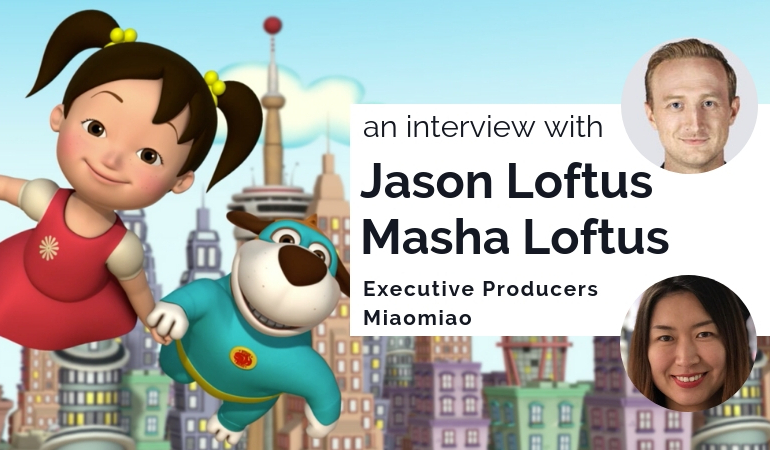Thank you to Lofty Sky Entertainment, producers of the Miaomiao television series and apps, for sponsoring this post. Opinions expressed here are my own.
There are so many resources available to help kids learn Chinese today, but how exactly do you first get them interested in speaking, reading and writing the language? Enter the Miaomiao animated TV series and apps, which introduce Mandarin Chinese to preschoolers and young children between the ages of 2 and 5.
Recently before Chinese New Year, I had the opportunity to sit down and speak with Jason and Masha Loftus, the husband-and-wife executive producers of the Miaomiao series based in Toronto, Canada. Through the conversation, I enjoyed hearing how language learning and entertainment converge, as kids follow Miaomiao and her animal friends through their imaginative world.
As a parent, I am struck by how seamlessly the Miaomiao TV series and apps fit with the other games and entertainment my son enjoys. Each video episode teaches a familiar lesson about friendship or problem-solving. Tracing Chinese characters in the app mimics similar games my son plays to practice reading and math. Miaomiao’s adventures rival anything the PJ Masks are up to, in terms of pure fun.
With this level of engagement, Chinese language learning happens in the background and in context. Each episode weaves a simple phrase in Mandarin into the plot, a storyline which often builds on Chinese cultural themes. The apps reinforce these words with additional repetition and the opportunity to practice writing the character. Put it all together and it feels like constructive screen time.
Functionally, Miaomiao provides a basic introduction to Mandarin Chinese — tones, pronunciation and simple vocabulary. More important, however, I think the series and apps can help engender positive feelings toward Chinese language and culture. And that is the first step toward an enthusiastic response when there’s the opportunity for a child to learn more Chinese in the future.
Jason and Masha shared their approach to making language learning fun and engaging, the families they think most enjoy Miaomiao and the best ways to get started with the series and apps. These are edited excerpts from our conversation.
Get involved! Visit Miaomiao online, on YouTube or Amazon Prime and at the iTunes App Store or Google Play Store. You can also follow Miaomiao on Facebook or Instagram.
Tell me about your multicultural family. As young parents today, how important is Chinese language and culture in your daily family life?
Masha Loftus: I grew up in the northeast of China in a city called Changchun. It was called Manchukuo before and was the capital of the last emperor of the Qing dynasty. I came over to do a masters degree at the University of Toronto and that’s where I met Jason. We attended a China Canada relationship conference and after that we decided to start our own China Canada relationship. Now we have two boys, 8 and 6, and my mom lives with us. My dad passed away about 4 years ago, but he lived with us as well.
Jason Loftus: Masha’s mother doesn’t speak a lot of English, so communicating with her made it important for our boys to maintain some foundation of Mandarin language. When they were young, Masha read with them and our eldest would recite songs, poems and different things. It was a joy to have that connection.
We tried to keep it strictly Mandarin, because Masha’s parents were helping at home and I can converse somewhat. Until the boys were 2 1/2, they didn’t actually speak any English. But as soon as they started going to school, they immediately wouldn’t want to answer in Mandarin anymore. Even if they understood what was going on, they would want to reply in English.
Slowly, the language and the vocabulary would disappear. That was the impetus for us to start the work we do around Chinese language education. We wanted to create something that would engage our kids and keep them seeing Chinese language in a positive light — something that’s fun, enjoyable and entertaining, as well as an important part of their culture.
From each of your perspectives, why is it important for your kids to learn about Chinese culture? What are your hopes for their language acquisition?
Masha: I’m extremely proud of my culture and want my children to feel the same pride, because I think it’s wonderful and fantastic. Chinese culture is so rich, with thousands of years of history and a good set of values. I try to make them interested in learning through play and doing things. For example, during holiday times, we make mooncakes and dumplings together. You’ll see a lot of these ideas included in the Miaomiao games.
Jason: I grew up in a small town where there were absolutely no people from anywhere else. It was very homogenous. When I got older, I developed an interest in Asian cultures and then China, in particular. I definitely endorse what Masha’s saying about the traditional values and I also wanted the kids to have a relationship with Masha’s parents, the ability to communicate and make that bond stronger. The more they understand through language, the more they can pass on.
There’s a pragmatic, educational aspect as well, because there are so many benefits associated with learning Chinese. It’s a pictorial language, which activates different parts of the brain. It’s a tonal language, which is connected with later education in music. Learning Mandarin as a second language is a great foundation for education and development, as well as for the culture and connection with the older generation.
I find that many creators begin their projects because of a dissatisfaction with what had been available at the time. How did Miaomiao get started? What gap are you trying to fill?
Jason: There is room for different approaches. We looked at a lot of educational tools when our children were young. The traditional Chinese approach to learning the language can be really rigorous, it’s 5,000 characters to drill at home. And there is definitely a value to that approach that we respect. But I think there is a bit of a cultural gap in the sense that a Western approach today emphasizes learning through play and entertainment, especially when you’re trying to introduce culture. Kids here might already feel like, “This isn’t everyone’s culture, so maybe I’m a little bit different.” You face that barrier, then add Saturday school and being forced to do 20 characters a day over and over again. That’s not going to help make learning a positive, fun experience that kids feel proud of and connected to.
This is why we took the approach of adding fun and play. We balance the polish of Western production with educational goals. Kids see someone who looks like them, who is obviously connected to the Western world, but proud of their heritage, culture and language. Once we have that foundation, we work with educational experts to bring up the learning through repetition. That’s the overall mindset.
Masha: I tried different products from mainland China and Taiwan. The ones from mainland China were pretty rigorous and ambitious, always teaching, teaching, teaching. The ones from Taiwan were more fun, but it made me aware of different Mandarin accents! I have friends who are Canadian Born Chinese with parents who forced them to learn Chinese when they were young and they hated it as a result. Now they regret not learning. All of this made me think about how to make our kids actually interested in learning.
Jason: We see Miaomiao as a foundation and a gateway. When kids enjoy learning Chinese and look at it positively, it provides a spark that can lead them to all the other kinds of educational learning. We work to make their impression of their language and culture positive and something that they’re engaged with and passionate about.
I think the tendency is to say, my product is for everyone! Who is Miaomiao for? What would you tell parents that their kids will get out of engaging with Miaomiao?
Jason: Generally speaking, we find that families that have emigrated here recently with parents who speak Chinese at home are not seeking out our product. When we focus test, we find our audience is made of people who have an affinity toward, or connection with, Chinese culture, but who don’t have a developed institution in the house where the language can happen naturally. Then there are just the growing number of people who may not have the direct connection with Chinese culture or heritage, but who have an interest in it.
Serving these users is our core, but at the same time there’s this instinctual part of it that, to be proud of something, it has to be personal and something you would enjoy yourself. So we incorporate a lot of things that our team enjoys, things we would share from our own experience. We have people with blended families. We have people who grew up with no family connection, but have learned on their own later on. With that diversity, we create things we would make for ourselves, then focus test with our audience, as well.
Masha: Miaomiao is not just for families with Chinese heritage. It’s fun, not too complicated and suitable for Western kids. We see increased interest in learning Chinese for educational purposes and future business opportunities. Especially in Canadian private schools, Mandarin has become the third language taught behind English and French.
I’m struck by the fun and contemporary nature of Miaomiao’s production. Take me through an episode. How does the show help kids learn Chinese? How does the show fit together with your printables and apps?
Jason: Miaomiao is fun, entertaining and positive, as a gateway to future learning. Within that framework, there are layers of education. We make it fun to start, then go deeper. Our 7 minute episodes tell a story that carries the child through that time with social-emotional lessons like teamwork, cooperation and not being selfish. In each episode, there’s one Mandarin term or phrase that they’re learning that connects with the episode’s theme. This is the entertainment-first mindset.
The app has 2 minute episodes with controls, so that parents can see what videos the child is watching and engage with what they’re learning. The app was built with the same fun, innocent and positive feeling and production values, but with additional repetition and educational focus.
These two different approaches dovetail nicely. The characters are consistent, you just go a little bit further with the education in the app. The app also has basic preschool learning games about shapes and colors, with the additional benefit of learning those words in Mandarin at the same time. It’s natural play with an added language element.
How does a technology product like the Miaomiao app add something new to the resources 2-5 year olds have to support language learning?
Jason: I think there are merits in all approaches, methodologies and sources of knowledge. Technology offers new tools that make things more expedient and straightforward to connect with children. For example, one early inspiration was this idea that Chinese characters are pictorial in nature. So, we introduced this traditional concept by making the character come alive through animation. For example, we transformed the character for mountain into a mountain. And the character for kabob looks like a kabob, so we played with that. You wouldn’t believe how long kids can spend tapping on these animations and having fun with them.
Invisibly, they’re learning that Chinese characters are interesting, not just complicated with a lot of strokes. There’s a meaning there that’s cool and something to be proud of. We convey some concepts that are foundational in learning this language, but do it in a way that’s totally fun and engaging. The learning almost happens by accident.
How should parents get started? What are your favorite episodes?
Masha: My favorite episodes involve this little bear called Benben, which means “dummy” in Chinese, but in a cute way. He is always kind of selfish, draws attention, but usually fails and embarrasses himself. My two boys always laughed at him and learned that you need to be a good team player. They also learned some simple, but useful words by watching those episodes.
Jason’s sister has three children who love the episode about making dumplings. They’re pure Western kids and for them, the best way to start is through Chinese cuisine and doing things together. That’s their favorite starting point.
It depends on the family’s situation, on how much their kids are already exposed to Chinese language and culture. I think it makes sense to start by learning to play with the characters. Textbooks from China are very theoretical and may not register in a child’s mind. In the iPad app, learning how water becomes the character for water, a lot of these basic words work really well in our family situation. To say, “OK, these aren’t too intimidating.” At the earliest stages, I think it’s important that kids have an interest and have confidence in learning a new language.
Jason: I really love the lemonade stand episodes. Kids are all different, with different interests and personalities. Our two young boys are always eager to do something, fun loving and very innocent. I love how Doudou describes what he’s doing in that lemonade episode. He’s doing a wine tasting with the lemonade Miaomiao is serving. I get a kick out of that.
We want to create something that parents can engage with, as well. To spark that shared experience of learning a culture, whether it’s something you are connected to or are connecting to because it’s interesting. Miaomiao is something you can use to start that journey together.
Finally, happy Lunar New Year! How will you be celebrating with your family this year?
Masha: Well, we need to eat right?
Jason: Dumplings, dumplings and more dumplings!
Masha: Our tradition is to put coins in the dumplings. And whoever finds the coin will have good luck in the new year!
###
Your turn! How do you keep language learning fun and engaging in your family? What inspiration do you draw from Jason and Masha’s story?








Leave a Reply